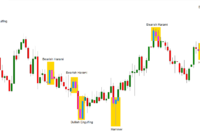bbc.towzdog.com – Navigating the forex market can be daunting, especially for beginners. To effectively participate in forex trading, it’s essential to understand the terminology used within the industry. This forex glossary of terms will define key concepts and jargon that traders encounter daily, making your trading experience smoother and more informed.
What is Forex Trading?
Introduction to Forex
Forex trading, or foreign exchange trading, involves the buying and selling of currencies on the foreign exchange market. It is one of the largest financial markets in the world, with a daily trading volume exceeding $6 trillion. Understanding the language of forex is crucial for anyone looking to engage in this market.
Why a Glossary is Important
A well-rounded knowledge of forex terminology helps traders:
- Communicate Effectively: Being fluent in forex terms allows you to discuss strategies and market movements with other traders and brokers.
- Make Informed Decisions: Understanding terms helps you interpret market news, analysis, and economic data.
- Minimize Risk: Knowledge of key concepts can aid in managing risks associated with trading.
Key Forex Terms Defined
Currency Pair
What is a Currency Pair?
A currency pair is the quotation of one currency against another. It consists of a base currency and a quote currency. For example, in the currency pair EUR/USD, the euro (EUR) is the base currency, and the U.S. dollar (USD) is the quote currency.
Importance
Understanding currency pairs is fundamental for forex trading, as they indicate how much of the quote currency is needed to purchase one unit of the base currency.
Pips
What are Pips?
A pip (percentage in point) is the smallest price move that a given exchange rate can make. In most currency pairs, a pip is usually equal to 0.0001, or one-hundredth of a percent.
Why Pips Matter
Pips are essential for measuring price movements in the forex market. For instance, if the EUR/USD moves from 1.1000 to 1.1005, it has moved 5 pips.
Spread
Understanding Spread
The spread is the difference between the bid price and the ask price of a currency pair. The bid price is the price at which the market will buy a specific currency pair, while the ask price is the price at which the market will sell it.
Types of Spreads
- Fixed Spread: The difference remains constant, regardless of market conditions.
- Variable Spread: The difference can fluctuate based on market volatility.
Leverage
What is Leverage?
Leverage allows traders to control a larger position with a smaller amount of capital. It is expressed as a ratio, such as 100:1, meaning for every $1 of your capital, you can trade $100 in the market.
Benefits and Risks
Leverage can amplify profits but also increases the risk of significant losses. Understanding how to use leverage responsibly is crucial for risk management.
Margin
What is Margin?
Margin refers to the amount of money required to open and maintain a leveraged position. It acts as a security deposit to cover potential losses.
Margin Requirements
Margin requirements vary by broker and are expressed as a percentage of the total position size. For example, if a broker requires a 1% margin, you need $1,000 to control a position worth $100,000.
Advanced Forex Terms
Stop-Loss Order
What is a Stop-Loss Order?
A stop-loss order is a pre-defined order to sell a currency pair when it reaches a certain price level. This helps limit potential losses in a trade.
How It Works
If you buy the EUR/USD at 1.1000 and set a stop-loss at 1.0950, your position will automatically close if the price drops to 1.0950, preventing further losses.
Take-Profit Order
Understanding Take-Profit Orders
A take-profit order is similar to a stop-loss order but is used to secure profits. It automatically closes a trade when the price reaches a specified level, locking in gains.
Technical Analysis
What is Technical Analysis?
Technical analysis involves evaluating currency pairs by analyzing historical price movements and chart patterns. Traders use various tools and indicators to forecast future price movements.
Common Tools
- Moving Averages: Help identify trends by smoothing price data.
- Relative Strength Index (RSI): Measures overbought or oversold conditions.
Fundamental Analysis
Understanding Fundamental Analysis
Fundamental analysis focuses on economic indicators, news events, and geopolitical developments that can impact currency values. Traders analyze economic reports, interest rates, and political events to predict market movements.
Key Indicators to Monitor
- GDP Reports: Reflects overall economic performance.
- Inflation Data: Indicates purchasing power and potential interest rate changes.
Understanding Market Sentiment
Bull Market and Bear Market
What is a Bull Market?
A bull market refers to a market condition characterized by rising prices. In forex, a bull market often indicates a strong demand for a particular currency.
What is a Bear Market?
Conversely, a bear market is marked by declining prices and pessimistic sentiment. Traders may take short positions to profit from falling prices.
Market Sentiment
Understanding Market Sentiment
Market sentiment refers to the overall attitude of traders toward a particular currency or market condition. Sentiment can be bullish, bearish, or neutral and is often influenced by news events and economic data.
How to Stay Informed
Follow Financial News Outlets
Staying updated on forex market news is essential for traders. Trusted financial news websites provide real-time updates and analysis.
Utilize Educational Resources
Many brokers offer educational resources, including webinars, articles, and tutorials, to help traders learn about forex trading.
Join Trading Communities
Participating in trading forums and communities can enhance your understanding of market trends and sentiment.
Conclusion
Navigating the forex market becomes significantly easier when you understand the terminology involved. This forex glossary of terms provides a solid foundation for both beginners and experienced traders. By familiarizing yourself with these terms, you can communicate effectively, make informed trading decisions, and ultimately enhance your trading experience.




